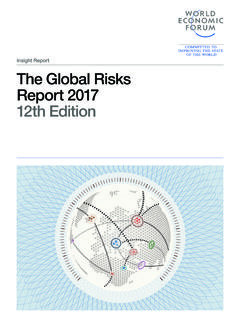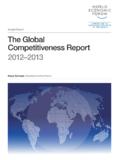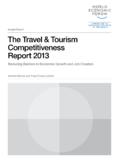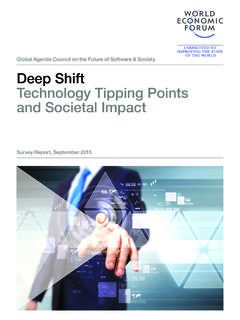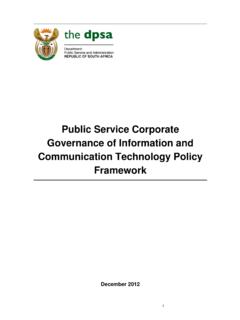Transcription of How to Set Up Effective Climate Governance on Corporate ...
1 How to Set Up Effective Climate Governance on Corporate BoardsGuiding principles and questionsJanuary 2019In collaboration with PwCWorld Economic Forum91-93 route de la CapiteCH-1223 Cologny/GenevaSwitzerlandTel.: +41 (0)22 869 1212 Fax: +41 (0)22 786 2744 Email: 2018 World Economic Forum. All rights reserved. No part of this publication may be reproduced or transmitted in any form or by any means, including photocopying and recording, or by any information storage and retrieval to Set Up Effective Climate Governance on Corporate BoardsForewordExecutive SummaryGlobal ContextClimate Governance principles and Guiding QuestionsOutlook and ConclusionAppendices:1. Legal perspective 2.
2 Investor perspective 3. Design of the principles and consultation process 4. Glossary of termsContributorsEndnotes567111819192122 232526 Contents4 How to Set Up Effective Climate Governance on Corporate Boards5 How to Set Up Effective Climate Governance on Corporate BoardsForewordClimate change is visibly disrupting business. It is driving unprecedented physical impacts, such as rising sea levels and increased frequency of extreme weather events. At the same time, policy and technology changes that seek to limit warming and reduce the associated physical impacts can also cause disruption to business. As with any form of disruption, Climate change is creating and will continue to create risks and opportunities for business in a diverse number of ways.
3 This disruptive relationship between Climate change and business is already receiving increased attention. This has been prompted by the Paris Agreement, the emergence of Climate -related legislation, the recommendations of the Financial Stability Board s Task Force on Climate -Related Financial Disclosures (TCFD) and, most recently, the heightened awareness of physical impacts and risks detailed in the Special Report of the Intergovernmental Panel on Climate Change (IPCC) on Global Warming C. In light of this attention, investors, regulators and other stakeholders are challenging companies to demonstrate an integrated, strategic approach to addressing Climate -change risks and opportunities.
4 An important element in ensuring that Climate risks and opportunities are appropriately addressed is the important duty that boards of directors have for long-term stewardship of the companies they oversee. However, to govern Climate risks and opportunities effectively, boards need to be equipped with the right tools to make the best possible decisions for the long-term resilience of their organizations. The goal of this work is to propose tools that can be useful for the board of directors to steer Climate risks and opportunities: the Governance principles are designed to increase directors Climate awareness, embed Climate considerations into board structures and processes and improve navigation of the risks and opportunities that Climate change poses to business.
5 By providing a compass to enable more Effective Climate Governance , this initiative strives to contribute to the Forum s Compact for responsive and responsible leadership and to sound an urgent call to action for purposeful stewardship from and for the most prominent custodians in corporations: their board of Waughray, Managing Director Centre for Global Public Goods, Member of the Managing Board, World Economic ForumJon Williams, Partner, Sustainability and Climate Change, PwCThe vision and action of Directors, CEOs and senior-level executives is fundamental to addressing the risks posed by Climate change and delivering a smooth transition to a low-carbon economy.
6 Materials, such as this new World Economic Forum report, that support Boards and Executives understand how to deliver on the TCFD can help foster a virtuous circle of adoption, where more and better information creates imperatives for others to adopt TCFD and for everyone to up their game in terms of the quality of the disclosures Carney, Governor, Bank of England and former Chair, Financial Stability Board6 How to Set Up Effective Climate Governance on Corporate BoardsExecutive Summary The links between Climate change and business are becoming increasingly evident and inextricable. Business decisions and actions will slow or accelerate Climate change, and Climate change will drive risks and opportunities for business.
7 Increasingly, board directors are expected to ensure that Climate -related risks and opportunities are appropriately addressed. However, limited practical guidance is available to help board directors understand their role in addressing these risks and opportunities. On the one hand, good Governance should intrinsically include Effective Climate Governance . To this point, Climate change is simply another issue that drives financial risk and opportunity, which boards inherently have the duty to address with the same rigour as any other board topic. On the other hand, Climate change is a new and complex issue for many boards that entails grappling with scientific, macroeconomic and policy uncertainties across broad time scales and beyond board terms.
8 In this regard, general Governance guidance is not necessarily sufficiently detailed or nuanced for Effective board Governance of Climate issues. This work seeks to provide useful guidance to boards, acknowledging that Climate Governance is both integral to basic good Governance and fraught with complexity. The result is a set of principles and questions to guide the development of good Climate Governance designed to help the reader practically assess and debate their organization s approach to Climate Governance and frame their thinking about how the latter could be made more robust. The principles and guidance build on existing Corporate Governance frameworks, such as the International Corporate Governance Network s (ICGN) Global Governance principles , as well as other Climate risk and resilience guidelines, such as the recommendations of the Financial Stability Board s Task Force on Climate -Related Financial Disclosures (TCFD).
9 The drafting process involved extensive consultation with over 50 executive and non-executive board directors, as well as important organizational decision-makers, including chief executives, and financial and risk officers. Input was also gained from experts from professional and not-for profit organizations. This consultation took place through a series of face-to-face and phone interviews over the course of four months, helping to shape and test the principles and guiding questions. This paper opens with details on the global Climate context, addressing changing regulations and increasing expectations of boards in the Climate arena. The bulk of the paper presents the eight Climate Governance principles and their associated guidance.
10 The eight principles are not presented in order of priority or in a fixed sequence, but do follow a logical flow and build upon each other. For example, principles 1 4 lay the foundation for Principle 5, and principles 6 8 help facilitate the endurance of attention to Climate -change issues in the long term. To make these principles practical and applicable, each principle is accompanied by a set of guiding questions that will help a company identify and fill potential gaps in its current approach to governing Climate . The paper is also supported by chapters that provide additional technical legal and investor context in the Appendix. Principle 1 Climate accountability on boards Principle 2 Command of the subject Principle 3 Board structure Principle 4 Material risk and opportunity assessment Principle 5 Strategic integration Principle 6 Incentivization Principle 7 Reporting and disclosure Principle 8 ExchangeThis initiative sought to make these principles both broadly applicable and practically useful for organizations.
